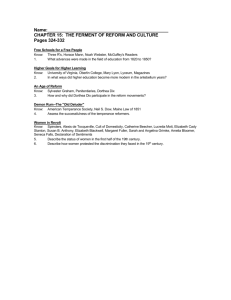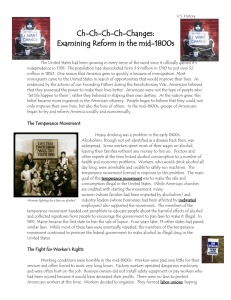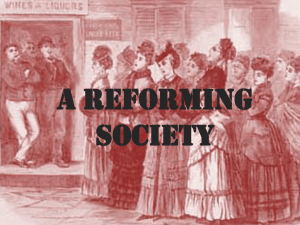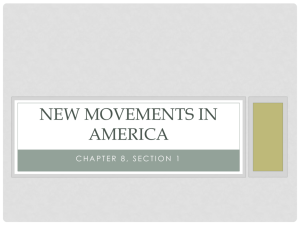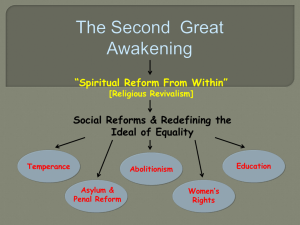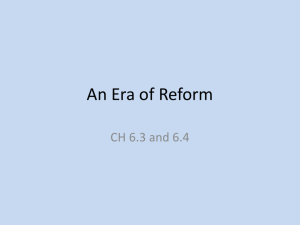1800s Reform Movements: Civil Rights & Liberties
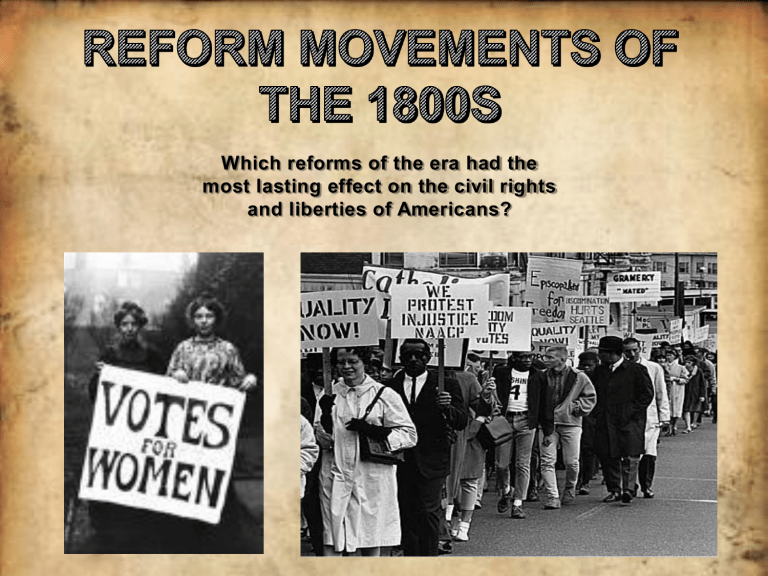
Which reforms of the era had the most lasting effect on the civil rights and liberties of Americans?
Reform Movement
Between about 1820 and 1850, American reformers devoted themselves to such causes as ending slavery, promoting women’s rights, protecting the mentally ill and improving education.
Great changes in America were about to happen and reformers were fighting for this change.
Why Reform????
Many people felt there needed to be reform or change in American society. It began with new religious movements. One of the main religious movements was called the Second
Great Awakening.
Optimism of the Second Great Awakening
Preachers during the Second Great
Awakening began telling their followers that they could “build a heaven on Earth” through doing good deeds. This inspired people to work hard and improve problems in society.
What reform do you think these religious communities wanted to tackle first?
Temperance Movement
Some Americans began the temperance movement. This was a campaign to stop people from drinking alcohol.
Many women joined the temperance movement and urged people to sign a pledge to give up alcohol.
Temperance Movement
Supporters of the temperance movement argued that alcohol was a social ill. Alcohol led to poverty, drunkenness and crime. They believed society would be much better if alcohol was prohibited. Many states banned the sale of alcohol. Overtime however, these laws were repealed
TEMPERANCE MOVEMENT
LEADER
American
Temperance
Union and
Religious leaders
GOAL to eliminate alcohol abuse
REASON alcohol led to crime, poverty, abuse of family
TEMPERANCE MOVEMENT
• Religious leaders stood at the forefront of the war against alcohol. – “The Devil’s Drink”
• Public drunkenness was common in the early 1800s.
• Alcohol abuse was widespread, especially in the West and among urban workers.
• Employers often paid part of workers’ wages in rum or whiskey.
• Workers took rum breaks similar to today’s coffee breaks!!
TEMPERANCE MOVEMENT
QUICK FACTS
• The American Temperance Society was formed in 1826.
• Alcohol consumption drops between 1830 - 1860
• Within a few years, about 1000 local organizations sprang up across the nation.
– Some groups took a moderate approach and asked people to drink less alcohol.
– Other groups insisted that the sale of alcohol be banned altogether!
– Maine goes dry in 1851
• Northern and Southern temperance societies used propaganda to win support for their cause.
– They held meetings, gave speeches, and distributed pamphlets.
– They even sang songs such as “Drink Nothing, Boys, but
Water,” and “Father, Bring Home Your Money Tonight.”
1834
1842
1851
1855
1919
1820s
1826
1831
1833
1920's
1933
TEMPERANCE MOVEMENT
The consumption of alcohol in the U.S. was 7 gallons per capita per year.
Boston area ministers founded the American Temperance Society (ATS).
American Temperance Society had 2,220 local chapters and 170,000 members.
American Temperance Union (ATU) founded, merging two existing national temperance organizations.
American Temperance Society had 5,000 local chapters, and 1 million members.
Washington Society publicized that they had inspired 600,000 abstinence pledges.
Maine prohibited the sale or making of any alcoholic beverage.
13 of the 40 states had prohibition laws.
On January 29th, the 18th amendment is ratified by 36 states and goes into effect on the federal level.
The rise of bootleggers such as Al Capone in Chicago highlight the darker side of prohibition.
On December 5th, prohibition is repealed with the 21st amendment.
Alcohol Consumption Today
• Do you consider the amount of alcohol
Americans consume in
2014 a problem?
• Why or why not?
PRISONERS AND THE MENTALLY ILL
(Prison and Asylum reform)
LEADER GOAL
Dorothea Dix better treatment of persons with mental illnesses and prisoners
REASON the mentally ill and prisoners badly treated
PRISONERS AND THE MENTALLY ILL
• During the mid 1800s prisons were a place to put children accused of petty crimes, the mentally ill and criminals.
• As a result, debtors, children who were offenders, and the mentally ill were often locked up in jails with murderers and thieves.
• Dorothea Dix worked to change
Americans’ ways of thinking about these institutions and their inmates.
Life in the Prison
-The prisons were horrible places where people were chained, whipped, beaten, and forced to stand naked in the confining cages.
- The mentally ill were treated particularly bad and were severely punished if they missed behaved.
Finally some help…………..
• Dorothea Dix first observed prison conditions while teaching Sunday school at a
Boston prison for women in 1840.
• She wanted to find out if all the prisons in the state were as appalling.
– She found the prisoners were often living in inhumane conditions.
– Prisoners were often chained to the walls with little or no clothing, often in unheated cells.
– she learned that some of the inmates were guilty of no crime—they were mentally ill persons.
I have observed mentally ill inmates chained naked to stone walls in cells without heat or ventilation. I have to do something for them.
2 year secret investigation at more than
800 prisons, jails, and poorhouses.
1840-1841
• Inmates dressed in rags
& poorly fed
• Chained together & or to walls
• All criminals housed together
Dorothea Dix wrote about the horrible things she saw in the prisons and worked tirelessly to improve the conditions in the jails.
Dix’ work leads to :
• construction of mental health facilities
• proper treatment for mentally ill
• Dix made it her life’s work to educate the public as to the poor conditions for both the mentally ill and prisoners.
TREATMENT OF THE MENTALLY ILL
• Dix decided to appeal to the Massachusetts government for help.
• In 1843 she addressed the following report to the state legislature:
“I proceed, gentlemen, to call your attention to the present state of
Insane Persons confined…, in cages, closets, cellars, stalls, pens!
Chained, naked, beaten with rods, and lashed into obedience…”
• As a result of Dix’s report, Massachusetts passed a law to build mental hospitals where mental illness could be treated as a disease rather than a crime.
• By 1852, she had persuaded 11 states to open hospitals for persons with mental illness.
Dorothea Dix and Mentally Insane
Through the reform work of Dorothea Dix, the government created new laws to handle children and the mentally insane within prisons.
More insane asylums were build to house the mentally ill. In the asylums they were treated as people with an illness, not as criminals.
Opinionated Wife: The Case of Elizabeth Packard
SAY SOMETHING ACTITIVY
• Elizabeth Packard, like many other women of her era, settled into domestic life as a wife and mother husband, her husband was a minister, and though she was a religious woman, she found herself at odds with his teachings. This
“defiance” led Minister Packard to have her committed to the state asylum at
Jacksonville, Illinois.
• Despite a lack of evidence proving insanity, her husband’s word and wishes were enough to have Packard committed, with the consent of the institution’s superintendent.
• Packard spent the 3 years in an institution before the hospital finally released her to her husband’s custody.
Opinionated Wife: The Case of Elizabeth Packard
• Only after a trial where Elizabeth was declared sane was she able to begin to escape from the authority of her husband—though her lack of property rights as a married woman still complicated matters greatly.
• Elizabeth Packard used her experiences to expose the poor state of mental health care. She was passionate about fixing this system that gave men such authority over women while not taking the time to hear patients’ voices.
Never returning to her husband, Packard devoted the rest of her life to this reform. She travelled around the country, fighting for and succeeding in gaining legislative changes that gave patients more rights. Due largely to her advocacy, laws were passed in places like her native Illinois that made a jury trial to prove insanity a requirement.
“Stunt Girl” Getting the Scoop:
The Case of Nellie Bly
1887
Ten Days in a Mad-House by Nellie Bly
• Nellie Bly— 23 years old and made her way to
New York to start her own investigative work on the prisons and treatment of the mentally ill.
• Went undercover! Nellie Bly managed to convince people—regular citizens, rival reporters, judges, officers, doctors and nurses— that she, posing as “Nellie Brown,” had lost her mind, leading to a confinement for ten days on
Blackwell’s Island.
• She first hand exposes the horrific conditions women had to go through.
…On bathing day the tub is filled with water, and the patients are washed, one after the other, without a change of water. This is done until the water is really thick, and then it is allowed to run out and the tub is refilled without being washed. The same towels are used on all the women, those with eruptions as well as those without. The healthy patients fight for a change of water, but they are compelled to submit to the dictates of the lazy, tyrannical nurses. The dresses are seldom changed oftener than once a month. If the patient has a visitor, I have seen the nurses hurry her out and change her dress before the visitor comes in. This keeps up the appearance of careful and good management. …….
“The Lunatic Asylum on Blackwell’s Island and the New York
Press,” American Journal of Psychiatry 164, no. 4, April 2007:
THE RETREAT
“For crying the nurses beat me with a broom-handle and jumped on me, injuring me internally so that I will never get over it. Then they tied my hands and feet and, throwing a sheet over my head, twisted it tightly around my throat, so I could not scream, and thus put me in a bathtub filled with cold water. They held me under until I gave up every hope and became senseless. At other times they took hold of my ears and beat my head on the floor and against the wall. Then they pulled my hair out by the roots so that it will never grow in again .”
“The beatings I got there were something dreadful. I was pulled around by the hair, held under the water until I strangled, and I was choked and kicked.
The nurses would always keep a quiet patient stationed at the window to tell them when any of the doctors were approaching. It was hopeless to complain to the doctors for they always said it was the imagination of our diseased-brains, and besides we would get another beating for telling. They would hold patients under the water and threaten to leave them to die there if they did not promise not to tell the doctors. We would all promise because we knew the doctors would not help us, and we would do anything to escape the punishment… Among other beatings I got there, the nurses jumped on me once and broke two of my ribs .”
…What, excepting torture, would produce insanity quicker than this treatment? Here is a class of women sent to be cured? I would like the expert physicians who are condemning me for my action, which has proven their ability, to take a perfectly sane and healthy woman, shut her up and make her sit from 6 A.M. until 8 P.M. on straight-back benches, do not allow her to talk or move during these hours, give her no reading and let her know nothing of the world or its doings, give her bad food and harsh treatment, and see how long it will take to make her insane……
Prisons Today
• Do you think prisoners should be given internet and news/media access?
• What issues do prisons face today?
Reforming Education
• Before the reform movements of the mid-1800s most children did not go to school.
The children of many poorer families needed to work and earn money.
Education Reform
LEADER GOAL
Horace Mann to educate all
Americans
REASON more Americans were qualified to vote and needed to be able to make wise decisions about their government
“Education does better than to disarm the poor of their hostility toward the rich; it prevents them from being poor .”
– Horace Mann
Education Reform
• American schools varied from section to section across the country.
• As early as 1647, Massachusetts passed a law requiring towns to provide schools for their children. The rest of
New England adopted similar laws. The towns, not the states, paid for the schools.
• Private societies in New York and Pennsylvania raised money to fund schools.
• Southern schools had even less support. In the South, families had to work so hard to make a living that little time or money was left for schooling.
• Wealthy people in all sections of the country managed to pay for privately operated schools.
Education Reform
• During the 1830s more Americans qualified to vote than ever before. Educational reformers argued that voters needed a proper education to make sound decisions about their government.
• Americans argued a country could not exist without literate citizens
– smarter citizens = better country
– helps the poor from being oppressed
• To accomplish these goals, they started the common school movement led by Horace Mann. (1837)
– Mann was especially concerned about poor children. Their families could not afford to send them to private schools or to contribute to the support of schools in their district.
– Not everyone favored common schools, also referred to as free, or taxsupported, public schools.
– many strongly objected to paying taxes for public schools.
Horace Mann
Horace Mann believed that more children needed to be given the opportunity to attend school. Horace Mann argued that education was the “great equalizer” and would “greatly improve America.”
He has become known as the “father of public education.”
Horace Mann Reforms Education
• Three main ideas
– Public education for all children
– Required attendance
– Proper training for teachers and enhanced curriculum
• “Normal Schools”
• The Boston Latin
School 1635
• University of
Pennsylvania 1636
School Not For Everyone…..
After his reform actions, most white children, especially boys, attended free public schools. It took many more years for girls and later African-American students to have access to free/public education. It was illegal to even teach a slave to read and write.
Your own school?
Hmm
. . .
• What are the biggest issues or concerns at your own school?
• What would be your solution to the problem?
• How would you go about putting this reform into place?
Women’s Rights
(The Suffrage Movement)
Leads to the 19 th Amendment (1920)
LEADER
Elizabeth Stanton,
Lucretia Mott,
Susan B. Anthony
GOAL obtain equal rights for women, including suffrage, right to own property, and education
REASON women did not have the same rights as men
Equal Rights for Women
• In the 1840s women were fighting for the rights of others and began to realize they too needed equal rights.
• Their involvement in the antislavery movement and other reform movements gave women roles outside their homes and families.
Equal Rights for Women
• They learned valuable skills, such as organizing, working together, and speaking public. (Note: it was considered “unfeminine” to speak in public!)
• Still, women were not treated equally and had little say over their own lives. Divorce was almost unheard of, women couldn’t control the money they earned, they couldn’t vote, and they didn’t have the right to buy or control their own property.
Women’s Rights
• After attending the World
Anti-Slavery Convention in
London in 1840 and not being allowed to participate in the discussions , Lucretia
Mott and Elizabeth Cady
Stanton spent hours talking about women’s position in society.
• They realized that they could not bring about social change if they themselves lacked social and political rights.
• On July 19, 1848 - the first women’s rights convention in U.S. almost 300 people (including 40 men) met in
Seneca Falls, New York to discuss women’s rights.
• The convention for women’s rights was led by Elizabeth Cady Stanton. She read a speech called the Declaration of
Sentiments.
• The Declaration Proposed rights for All women.
It began with these words, “We hold these truths to be self-evident that all men and
WOMEN are created equal…”
Read the first two paragraphs of The Declaration of Independence and the first two paragraphs of the Seneca Falls Declaration.
Declaration of Independence
IN CONGRESS, JULY 4, 1776
The Unanimous Declaration of the Thirteen United States of America
When in the Course of human Events, it becomes necessary for one People to dissolve the Political
Bands which have connected them with another, and to assume among the powers of the earth, the separate and equal Station to which the Laws of Nature and of Nature’s God entitle them, a decent
Respect to the Opinions of Mankind requires that they should declare the causes which impel them to the separation.
We hold these Truths to be self-evident , that all Men are created equal, that they are endowed by their Creator with certain unalienable Rights, that among these are Life, Liberty and the Pursuit of
Happiness
—That to secure these Rights, Governments are instituted among Men, deriving their just
Powers from the Consent of the Governed, —That whenever any Form of Government becomes destructive of these Ends, it is the Right of the People to alter or to abolish it, and to institute new
Government, laying its Foundation on such Principles, and organizing its Powers in such Form, as to them shall seem most likely to effect their Safety and Happiness.
The Declaration of Sentiments (1848)
Elizabeth Cady Stanton and Lucretia Mott
When, in the Course of human events, it becomes necessary for one portion of the family of man to assume among the people of the earth a position different from that which they have hitherto occupied, but one to which the laws of nature and of nature's God entitle them, a decent respect to the opinions of mankind requires that they should declare the causes that impel them to such a course.
We hold these truths to be self-evident: that all men and women are created equal ; that they are endowed by their Creator with certain inalienable rights; that among these are life, liberty, and the pursuit of happiness; that to secure these rights governments are instituted, deriving their just powers from the consent of the governed. Whenever any form of government becomes destructive of these ends, it is the right of those who suffer from it to refuse allegiance to it, and to insist upon the institution of a new government, laying its foundation on such principles, and organizing its powers in such form, as to them shall seem most likely to effect their safety and happiness.
Declaration of Sentiments
Just like the Declaration of Independence listed the acts of tyranny (cruelty) by King George over the colonies, The Declaration of Sentiment listed the acts of tyranny by men over women and their proposed solutions.
Women’s Rights
• The Seneca Falls Convention marked the beginning of an organized women’s rights movement.
• Following the convention, women did not achieve all of their demands. They did, however overcome some obstacles.
– Many states passed laws permitting women to own their own property and keep their own earnings.
• Many men and women, though, continued to oppose the movement. Most politicians ignored or acted hostile to the issue of women’s rights.
Women’s Rights
• Susan B. Anthony , a powerful organizer, joined the women’s rights movement.
Her father encouraged her to get an education and so she became a teacher.
• A dedicated reformer, Anthony joined the temperance movement and worked for the
American Anti-Slavery Society.
• She became one of the first to urge full participation of African Americans in the women’s suffrage movement.
• Through her efforts, the state of New York agreed to grant married women the guardianship of their children and control of their own wages.
• Today Anthony is one of the early movement’s best-remembered leaders.
American Women Today
• What stereotypes do American women face now?
• Do you feel they are equal to
American men?
ABOLITION OF SLAVERY
LEADER
Frederick Douglass,
Sojourner Truth,
William Lloyd
Garrison, anti-slavery groups
GOAL end slavery
REASON it is immoral for one person to own another
ABOLITION OF SLAVERY
• By 1840, nearly 2.5 million enslaved people lived in the South.
• At one time, the North also had slavery. By
1804 every Northern state legislature had passed laws to eliminate it.
• The Southern economy, though, depended on slave labor.
ABOLITION OF SLAVERY
• The American
Colonization Society, founded in 1817, wanted to help free African
Americans.
• The society set up a colony for free African
Americans in Liberia, in western Africa.
• It was not successful because many African
Americans wished to remain in the United
States, their home.
ABOLITION OF SLAVERY
• In 1831 white abolitionist
William Lloyd Garrison founded The Liberator , a
Boston anti-slavery newspaper.
• In the first issue,
Garrison demanded the immediate emancipation, or freeing, of all enslaved persons.
• He urged abolitionists to take action without delay.
ABOLITION OF SLAVERY
• The North had many prominent African American abolitionists.
• Isabella Baumfree, although born into slavery in New
York, gained her freedom when New York abolished slavery. She changed her name to Sojourner Truth and vowed to tell the world about the cruelty of slavery. She began a tireless crusade against injustice.
ABOLITION OF SLAVERY
• The most important spokesperson for the cause was Frederick Douglass.
• Born into slavery, Douglass secretly taught himself to read, although Southern laws prohibited it.
• He escaped from slavery in
1838 and settled in
Massachusetts.
• He captivated audiences by talking about his life in bondage.
• He spoke out against the injustices faced by free African
Americans.
• Many abolitionists, like
Douglass, did more than lecture and write. They became “conductors” on the Underground Railroad.
• The Underground Railroad began around 1817. It was not an actual railroad but a series of houses where conductors hid runaway enslaved persons and helped them reach the next
“station.”
• Enslaved African Americans made their way to the North or Canada on the railroad.
ABOLITION OF SLAVERY
“There was one of two
• Harriet Tubman became the most famous African
American conductor
things I had a right to, liberty or death; if I could not have the one, I
on the Underground
Railroad.
would have the other.”
• Tubman fled from slavery in 1849.
Later she explained why she risked her life to escape:
ABOLITION OF SLAVERY
• Tubman helped others escape. She returned to the South 19 times and led more than 300 enslaved people— including her own parents—to freedom.
• Slaveholders offered a reward of $40,000 for her, dead or alive.
• But she managed to avoid discovery time after time.
How do you think the conductors and escaped slaves communicated long distance if the majority could not read or write?
QUILT CODES
• People who worked and traveled on the Railroad used secret codes to learn the routes from one safe place to the next.
• Researchers recently learned that an Underground Railroad Quilt
Code existed to guide fugitives to freedom.
• Because it was illegal in slave-holding states to teach slaves to read, slaves could not communicate with each other in writing. But, because slaves of all backgrounds shared an oral history of storytelling coupled with a knowledge of textile production and African art they discovered they we re able to communicate complex messages in the stitches, patterns, designs, colors and fabrics of the
American quilt.
• To memorize the code, researchers believe they used a sampler quilt, with blocks arranged in order of the code. The patterns told slaves how to get ready to escape, what to do on the trip, and where to go.
Once stitched, the coded quilts were “aired” out the windows of slave cabins, acting as secret maps
QUILT CODES
QUILT PATTERNS & THEIR MEANINGS
EXAMPLE OF A REAL QUILT
Lets try to decode the message!
Lets try to decode the message!
OLD STORY
"The monkey wrench turns the wagon wheel toward Canada on a bear's paw trail to the crossroads . Once they got to the crossroads , they dug a log cabin on the ground. Shoofly told them to dress up in cotton and satin bow ties and go to the cathedral church, get married, and exchange double wedding rings. Flying geese stay on the drunkard's path and follow the stars."
